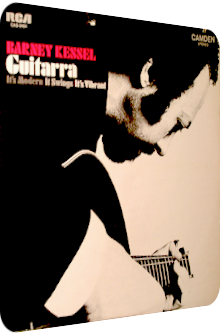
Barney Kessel
Guitarra
1970
If North American artists want to revive their careers, regardless of their current state, whether they are still entirely well-oiled or due to preventing writer’s block, they sure as hell travel around the globe in order to get inspired. Even better if the marketing department funds the whole trip and one record or two come to fruition during the process. I’m not being snarky here, especially not when talking about vintage material of the 50’s and 60’s, to which the Italian period of famed Jazz guitarist Barney Kessel (1923–2004) certainly belongs.
Guitarra is the first of these works that are recorded on site in Rome in May 1969, right at RCA Camden’s Studio B. Nine compositions find their way onto the LP, four of them written by the bandleader himself. And what a band he leads! Since Kessel is also known for offering his services as a session musician in various setups and genres – Josephine Premice’s Calypso sparkler Caribe (1957) marks one such curiously fantastic instance – he instead leads a band of Italian artists himself who also have had their fair share of experience in the vivid session musician movement of the time. Giovanni Tommasco plays the electric baritone bass, adding a warm oomph to both fast-paced and genteel tracks, drummer Enzo Restuccia meanwhile amplifies the playfulness of the material, with organist Antonello Vannucchi being right in the center with Barney Kessel, enchanting with glissando serpentines and legato trade winds. Enter Guitarra, also known as Kessel’s Kit, both titles of which do not do the aura of insouciance any justice. But that, I am sure, is its only flaw.
The warmest guitar chords straight out of Rome, all of them gorgeously soothing. This picture alone is worth a thousand positive vibes. All the better that this train of thoughts is oh so true, and Barney Kessel’s own B.J.’s Samba showcases this splendidly. Post-Bebop rhythm organs, a Samba undercurrent that is aptly realized by Enzo Restuccia, Barney Kessel’s helicoidal sunbeam-emitting coils and an overall lively atmosphere, this Samba exudes a cosmopolitan universe not entirely unlike Piero Umiliani’s Bon Voyage!!! (1972), that’s for sure. Meu Irmão by Carlo Pes is adjacent to the uplifting tunnel vision and itself a fast-paced corker with almost tangible hexangular organ sizzles whose lava-like parallax surface fuels and boosts Kessel’s Space-Age chords and the hectic drum diorama. Like a tune specifically made for a race track, it augments euphoria and spices it with euphony.
The following Malibu, however, is different. Originally envisioned by Italian film composer Armando Trovajoli, it is one of Kessel’s soothing interpretations, a downbeat beach scenery with cautiously clinging triangles and a crisp bass guitar as played by Giovanni Tommasco. While the beach is wide, the corset is willfully narrowed, and instead of a vivacious independence, interdependence is king on this beach. What a dreamy mirage. Barney Kessel’s own On The Riviera closes side A with a fast-paced piece supercharged with Latin nostalgia, ghostly organ shadows and an increasingly argentine percussion scheme, further toning down the exuberant glee of the first two tracks.
Side B launches with something that could be called an addendum to Malibu, namely Lison by Carlos Pes. Neither as laid-back and slow, nor as mellow as the former beach, the power of Lison derives from Kessel’s guitar sinews, the textural craftsmanship of the mellifluously plucked strings. The droning organ cloudlets then encapsulate what is basically a strongly guitar-based arrangement. Whereas Freeway by the Italian Disco brothers Mario & Giosy Capuano astutely continues the joyride and spirit of sports cars that wafts through the album most of the time, running on all cylinders drum-wise and literally sporting sophisticated guitar globs and oozing organ gas, Kessel’s own From My Heart is a gorgeously oneiric tryst of harmonies in major, with the bass guitar being retrojected on the golden chords which cajole their way into the ears. Ligneous percussion rounds off a very silky and rural piece about the good things in life.
Kessel continues the pace with another unique cut: Swing Samba sees organist Antonello Vannucchi return to splashier organ fusillades, all the while Enzo Restuccia presents an almost choo-chooing rhythm aorta whose upbeat manner revs up the subtheme of traveling through Italy with fast vehicles. The organ solo further stresses the cheekier approach, before the finale Amelia, a song by Antonio Coggio and Cesare De Natale finishes the veiled album with a slow plasticizer that melts away with its mélange of languorous guitar and organ billows in the endemic tradition of the slower material that graces this LP as well.
Do you prefer Barney Kessel’s smoking-fast licks, the occasional sunburst full of gleaming textures or the tropical verdure that emanate in front of his slower chords? Guitarra features all of these notions and motions. This is more than a mere trip to Italy, for the material is freed from any premonition. Kessel’s Italian albums – Guitarra and the 1970 follow-up Reflections In Rome – breathe the spirit of freedom, excitement and contemplation. It is the very reason romantic movies from the golden era of Hollywood more often than not depict people traveling to faraway places, first falling in love with the respective city, then with a fellow tourist or local citizen. These feelings are all encapsulated in Kessel’s process of realizing an opportunity by forming a new band on site in Rome. Naturally, Guitarra works also well enough when it is detached from history, without the listener in the know about this being an Italian album.
The organ proves to be a great addition to the material. Antonello Vannucchi manages to ameliorate and transmogrify the arrangements, especially so the two sambas which would normally beg for a Latin piano, but turn into locationless moirés, if that makes any sense. Together with the superb recording technique, the well-fed and pulsating bass guitar, lively drum layers and of course Kessel’s twelve-stringed artifact in the epicenter, Guitarra is a fantastic drive-through, with many a stopover near a beach in order to take a break and unfurl silkier, more sylvan counterparts to the perceived race tracks of the mind. Believe it or not, but Guitarra has not yet been reissued, so the vinyl or rips thereof are the only options at the time of writing this review. But the possession of the vinyl is worth it for every Exotica fan in general and, obviously so, Barney Kessel fans in particular.
Exotica Review 491: Barney Kessel – Guitarra (1970). Originally published on Jan. 24, 2018 at AmbientExotica.com.
